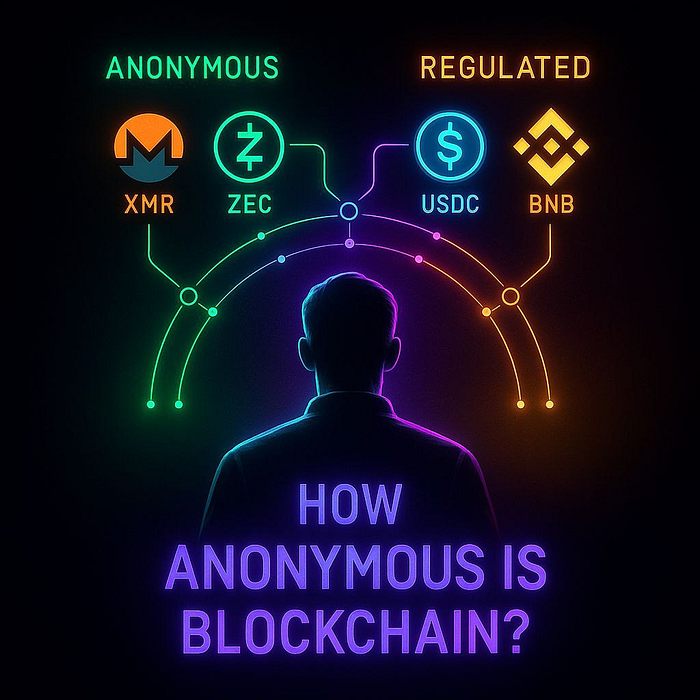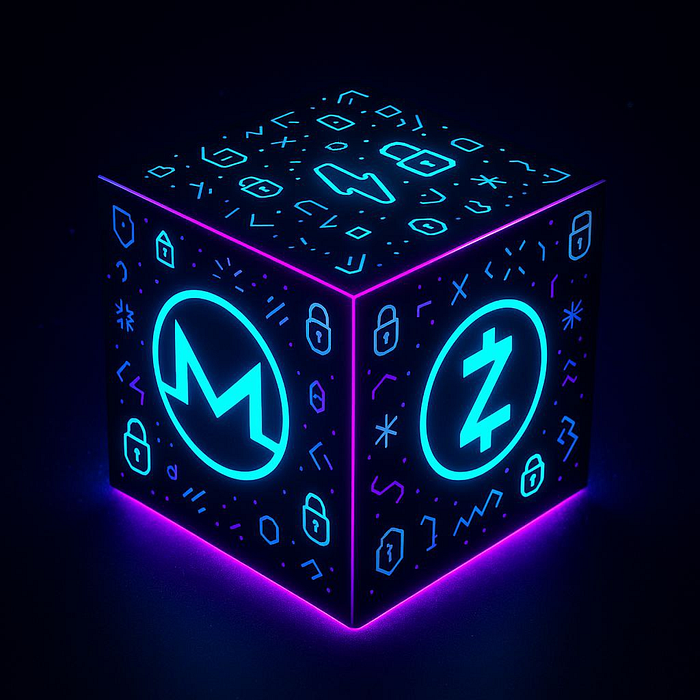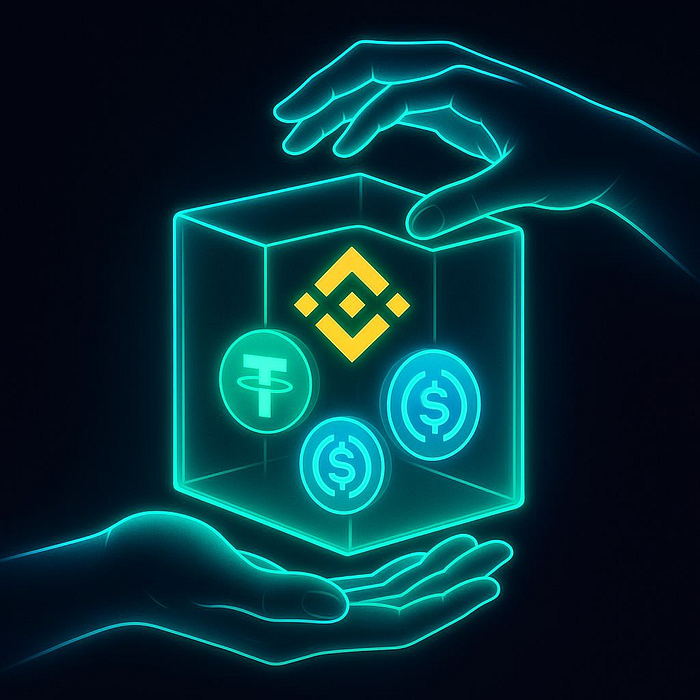A Cheat Sheet on Privacy in Crypto

At the dawn of Bitcoin and blockchain in general, a popular belief took hold: Bitcoin was anonymous. Anyone could generate a wallet and send funds, buying Bitcoin was easy, and there was no reporting to anyone. Bitcoin skeptics saw this as a danger: “an honest person has nothing to hide, only criminals need anonymous money.” Bitcoin optimists praised the very same thing.
Fifteen years later, it’s no longer fashionable — even embarrassing — to say “Bitcoin is only for criminals.” Instead, a new narrative has appeared: Bitcoin is no longer anonymous. Now we hear that governments can trace senders, exchanges demand ID checks, and every transaction is visible to anyone — therefore, some argue, there’s no point in blockchain anymore.
This confusion of narratives only scares away newcomers. Even regular crypto users sometimes struggle to understand: what exactly is anonymous in blockchain, and what isn’t?
This article gives a detailed answer: what counts as anonymous, and what doesn’t, in the blockchain world of 2025.
Quick Answer: So, Is Blockchain Anonymous?
The short answer: no, most blockchains are pseudonymous.
What does that mean?
- Your name and ID are not used anywhere in the protocol.
- But the entire history of transactions is public and immutable. You can’t erase, rewrite, or edit it.
- Which means it can be analyzed. Anyone can trace funds across blockchains and, using analytics methods, detect behavioral patterns and even “link” wallet addresses to specific people or organizations.
Why is it this way? In Satoshi Nakamoto’s vision, cryptocurrencies (starting with Bitcoin) were meant to give the user full control. No one can deny you an account — anyone can generate a wallet. No one can “freeze” your transactions — blockchain architecture doesn’t allow it; at best, funds can only be sent back. But the flip side is: users must evaluate the reliability of their counterparties themselves. And for that, addresses and their full history must remain public — so anyone can decide whether to do business with you.
That’s how Bitcoin works. Other blockchains have their own nuances: some are fully decentralized and privacy-oriented, others completely transparent. Even Bitcoin can feel “non-anonymous” in practice. Many users are still surprised when they download Binance and discover KYC passport checks: “I was promised anonymity — where is it?”
We’ll break it down along two verticals:
a) the blockchains themselves;
b) the services built on them.
And finally, we’ll share tips on how to reach the level of privacy that works for you.
Blockchains: From the Most Private to the Most Transparent

Anonymous Blockchains
If privacy and anonymity are your only priorities, keep this in mind: the only truly private blockchains are Monero (XMR) and ZCash (ZEC). All others — including Bitcoin — are pseudonymous.
What Monero and ZCash have in common:
- Not supported by most mainstream wallets;
- Delisted from many centralized exchanges — partly due to regulatory requirements, partly to avoid compliance risks;
- Both preserve transaction privacy and blockchain anonymity;
- Both use advanced cryptographic tools to hide sender, receiver, and transaction amounts.
That said, Monero and ZCash are built differently inside:
Monero (XMR): a fully decentralized, community-driven blockchain. Every Monero transaction is private by default — visible only to sender and recipient. Privacy is achieved through ring signatures, stealth addresses, and RingCT (confidential transactions). Monero also integrates with Tor and I2P to shield user metadata. Its community regularly changes the mining algorithm (RandomX) to:
a) remain ASIC-resistant;
b) allow ordinary PCs to mine Monero.
ZCash (ZEC): governed by the Electric Coin Company and the Zcash Foundation. ZCash supports two transaction types: pseudonymous and shielded. By default, transactions are transparent; to enable privacy, users must opt in with shielded addresses (starting with “z”). These are slower to process but deliver strong privacy. Shielded mode relies on zk-SNARKs (zero-knowledge proofs), which prove transaction validity without revealing underlying data.
Summary: Monero is for purists who want uncompromising privacy. ZCash is somewhat simpler in some aspects, weaker in others, but both provide the highest level of anonymity available in blockchain today.
Major downsides for both:
Prices are determined mostly on DEXs, not CEXs, leading to higher spreads and fees;
Liquidity is relatively low, which makes trading more difficult;
In the event of theft or a scam, recovering funds is virtually impossible.
At YLDX, we do not work with or invest in anonymous blockchains such as Monero or ZCash. There are three reasons for this: first, they remain highly niche solutions that do not fit the needs of most investors. Second, they are difficult to integrate into broader ecosystems — they lack compatibility with smart contracts and other DeFi infrastructure, which makes them weak from an investment standpoint. And third, they do not meet the criteria for inclusion in our pools, which focus on liquidity depth, market capitalization, and ranking among the leading digital assets.
Pseudonymous Blockchains: From the Most Decentralized to the Most Centralized

As noted earlier, the vast majority of blockchains fall into the “pseudonymous” category. The real question is: how much control do you, as a user, actually have over your funds?
With Bitcoin, things are straightforward. As of 2025, Bitcoin remains the most decentralized network in the world. Protocol changes happen only by broad consensus, requiring campaigns as complex as national elections in a small country. Despite Vitalik Buterin’s influence and the Ethereum Foundation’s presence, Ethereum is also not centrally governed — changes take time and coordination. Litecoin and even DOGE (despite Elon Musk’s vocal involvement) also maintain high degrees of decentralization.
Other popular blockchains are more centralized, though in different ways. Polkadot combines decentralized governance with a “relay chain,” while the Web3 Foundation has substantial influence. In Cosmos and Avalanche, large validators hold a significant share of staked tokens. Solana faces similar dynamics. In NEAR and TON, protocol development is strongly influenced by their foundations, and TON in particular restricts the number of validators.
Can you “disappear” inside a non-anonymous blockchain?
Yes, in theory.
Basic method: use bridges or swaps between blockchains. Since all transactions are visible, the idea is to lengthen the trail, then “break” it by swapping BTC for ETH, ETH for Solana, Solana for TON, and so on. This can be done via simple exchanges or cross-chain bridges.
More complex method: “hiding” transactions inside EVM-compatible chains. It’s very important point: most of investments product are built on EVM-based architecture
EVM-compatible networks (like BNB Chain, Avalanche C-Chain, Polygon, Arbitrum, Optimism) support Ethereum smart contracts. Within these chains, assets can move through DEXs, liquidity pools, staking and lending protocols, and bridges. Technically, DeFi protocols make money flows more transparent — but for most users, tracing those flows becomes far more complex.
For example, if a malicious actor steals your funds, they could swap them on Ethereum, route them through a DEX, spread them across multiple wallets in Solana, lock them in staking to receive derivative tokens, then sell those for fiat. From the outside, many of these steps appear as ordinary transfers because the operations happen inside smart contracts. You won’t see the full chain of events just by browsing blockchain explorers — at best, only fragments, and even those can be difficult to match.
The user’s question: How can I be sure that when I invest through YLDX, my funds don’t “dissolve” in DeFi protocols or disappear into untraceable wallets, but remain invested as intended in the designated smart contracts?
We solve this challenge in three ways:
1. Application
From the alpha release onward, our app will show full tracing of every coin across wallet chains. Every transaction will be transparent to the end user.
2. Architecture
By the end of 2025, our architecture is scheduled to undergo an external audit. Independent experts will verify that the system operates exactly as described and delivers the transparency we promise.
3. Licensing
YLDX.ai is in the process of licensing under the European MiCA regulation. This will provide regulatory confirmation of our reliability as a financial services provider.
Regulated Crypto and CBDCs

At the very bottom of the anonymity scale are regulated crypto protocols that largely comply with regulatory requirements, as well as central bank digital currencies (CBDCs) — such as the digital ruble.
Examples include the crowd favorite Tether (USDT) and USDC from Circle. These stablecoins are not independent blockchains; they are deployed on top of existing networks.
The defining feature of both protocols is the issuer’s ability (Tether or Circle) to freeze and block funds across any supported network. Typically, this requires nothing more than a formal request from law enforcement in a major jurisdiction.
Circle goes even further: it fully complies with European regulations, including the MiCA framework. That means even less anonymity in practice.
BNB Chain represents the opposite of Bitcoin. It is openly centralized and directly governed by Binance. Validators are selected and appointed by Binance, and the exchange’s cooperation with regulators is extensive.
Another key point is distribution. The majority of BNB Chain’s activity comes from Binance users — and most of them have already passed KYC checks. As a result, many transactions inside BNB Chain are non-anonymous by default, because Binance already holds the identity documents of most participants.
At YLDX, we integrate regulated assets (like USDC) into pools precisely because they combine liquidity depth with regulatory acceptance — even though anonymity here is minimal.
A curious reader might ask: “But many Binance users don’t even touch BNB — they only hold USDT or Bitcoin wallets there! Does that mean a huge portion of addresses in these blockchains are non-anonymous from the start?”
That’s correct.
So far we’ve looked at blockchains and touched a bit on protocols. Now let’s move on to products: which of them operate anonymously, and which do not?
Tools: From Anonymous to Non-Anonymous
Wallets
All blockchain wallets can be divided into two categories: custodial and non-custodial. Put simply: non-anonymous and (potentially) anonymous.
Non-custodial wallets can be downloaded, launched, and used immediately — no KYC required. Funds in a non-custodial wallet are controlled only by the wallet’s owner. Examples include popular multi-asset wallets like Trust Wallet or Exodus, as well as chain-specific wallets like TonWallet, MetaMask, or Solflare.
The well-known “cold wallets” (such as Ledger) are in fact a subtype of non-custodial wallets, taking the form of dedicated hardware devices.
Custodial wallets, by contrast, have a “custodian” — usually a centralized exchange like Binance. Custodians hold ultimate control: funds can be frozen, and KYC is typically required for access.
Are non-custodial wallets fully anonymous, and custodial ones fully non-anonymous?
Not exactly. Sometimes it’s even the other way around.
If you use a non-custodial wallet regularly, and it has a long transaction history, you can be deanonymized through on-chain analytics. Over time, transaction amounts, timestamps, and links to other wallets accumulate — and the more data points there are, the easier it becomes to infer who’s behind the wallet.
Custodial wallets are, of course, fully transparent to the exchange itself, and their data can be disclosed to law enforcement. But for external observers, transactions through an exchange can actually look more shielded than those through non-custodial wallets. This is because transfers between users inside an exchange may appear outwardly as transfers between exchange wallets.
Example: Suppose Alice and Bob don’t want outsiders to know they have a financial relationship. If they use personal wallets with known addresses, their connection is visible to anyone who inspects the blockchain. But if Alice deposits funds into an exchange, and Bob withdraws from the exchange to his wallet elsewhere, the exchange functions as a black box, obscuring the internal transfers. If both use wallets within the same exchange, the transfer may not even appear on-chain at all.
Edge cases
Your non-custodial wallet can also interact with smart contracts that require KYC. In such cases, while you still control the funds directly (unless specified otherwise by the contract), once the service requests KYC, those funds are effectively non-anonymous.
At YLDX, all liquidity pools are non-custodial by design: users retain ultimate control over their funds, while our compliance framework ensures regulatory alignment. This way, users don’t face the trade-off between anonymity and security — they gain both control and transparency.
Conclusion
In 2025, pseudonymity is the norm. Most blockchains are not anonymous, but they give users a level of control that traditional finance never offered. Fully private chains like Monero and ZCash exist, but they remain niche, illiquid, and impractical for most investors. At the opposite end, regulated assets such as stablecoins or CBDCs minimize anonymity, yet provide the liquidity and compliance needed for real-world adoption.
Tools matter as much as chains. Custodial wallets offer convenience but little privacy. Non-custodial wallets empower users with direct control, though over time they can still be deanonymized through on-chain analytics.
The emerging middle ground is CeDeFi — combining transparency and user custody with regulatory safeguards. This is the approach we take at YLDX: users always see where their funds are, remain custodians of their own assets, and benefit from both third-party audits and regulatory licensing.
In other words, anonymity is only part of the equation. The real goal is to give every investor confidence that their capital is secure, visible, and working exactly where it should be.